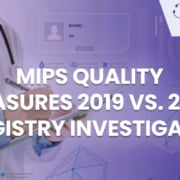MIPS Qualified Registry VS Qualified Clinical Data Registry
There are not many agencies in the US healthcare system that earns the status of MIPS qualified registry. Each of the seven MIPS submission methods has its own advantages, and eligible clinicians can choose to submit data via anyone.
However, healthcare organizations or physicians often confuse MIPS qualified registry and Qualified Clinical Data Registry (QCDR). Particularly, physicians who don’t have much knowledge about the MIPS 2019 reporting process and mechanism, find it difficult to decide the submission strategy.
P3Care being the MIPS qualified registry for three years now has the expertise and knowledge to know how things work with different submissions methods.
Here’s a quick overview of the two most confusing terms in the MIPS QPP.
A MIPS registry reports clinical data on behalf of eligible clinicians or healthcare organizations.
While QCDR is a CMS-approved entity that collects clinical data for CMS on physicians’ behalf. This entity is generally not managed by an individual. It also differs from the former submission method, as it is not restricted to certain measures for data submission.
The qualified clinical data registry is also allowed to host non-MIPS measures, which are approved by CMS.
The categories for QCDR reporting measures are as follows:
- National Quality Forum (NQF) endorsed measures
- Current 2019 MIPS measures
- Measures in regional quality collaborations
- Other measures approved by CMS
- Measures used by boards or specialty societies
- Clinician and group consumer assessment of healthcare providers and systems (CAHPS), measures reported by CAHPS certified vendor
- National specialty societies administer or endorse registries/ QCDRs
Reporting Mechanisms
Depending upon the reporting type and category, physicians can submit data via any mechanism.
Either as a group, individual, or virtual group, there are four performance categories to report on, Quality, Improvement Activities (IA), Promoting Interoperability (PI), and Cost.
For the cost category, you specifically don’t need to submit data, but CMS will use administrative claims data.
Both submission methods, qualified registries for MIPS and QCDRs can report for a total of six measures and all-cause readmission measures for groups of sixteen or more.
Which Method to Choose?
Either whatever method you choose to report, the decision should not be supported by the number of available measures. Instead, it should be well thought of to score high in the final score of MIPS in healthcare.
Think of the following points before finalizing the submission method.
- If measures are related to your practice
- The benchmark for available measures for each submission method
- Performance rate achievable for selected measures
- If there are bonus points available for the selected measures
- Information about which measures are topped out
A correct decision can make all the difference. The path to get incentives and bonuses leads to improved revenue cycle management.
Medical practices when improving the quality of healthcare services move towards progression, and MIPS QPP is a way to measure and judge the performance of how far we have come across.
Either you report via a MIPS qualified registry or any other method, the thing is to clear your mind, put forward pros and cons, and then strategize to report clinical data to MIPS via the most suitable method.

















MIPS qualified registry and qualified clinical data registry are very familiar and are good for all the physicians. Always submit your MIPS on time.